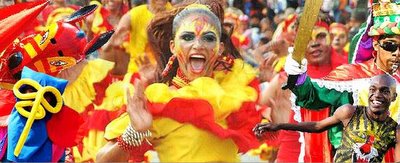 Yes, we also have a carnaval. And it happens to be the second biggest in the world. Not many people know about it although its history goes back to colonial times. However, most of the main characteristics of today´s carnaval started to appear in the nineteenth century with the adoption of the Rey Momo (Momo king): the son of dreams and night.
Yes, we also have a carnaval. And it happens to be the second biggest in the world. Not many people know about it although its history goes back to colonial times. However, most of the main characteristics of today´s carnaval started to appear in the nineteenth century with the adoption of the Rey Momo (Momo king): the son of dreams and night.The Barranquilla Carnaval officially begins on the middle of January with the reading of the "mandate" (... or something like that). Then throughout the rest of January and beginning of February many events occur in the city: concerts, drinking and partying. On the friday before the "carnaval saturday", in the middle of February, the first parade appears in the city: La Noche de Guacherna (noche = night, guacherna = a party to introduce the oficial carnaval season). After this night of intense party, more concerts, more drinking and more events cover the city through night and day.
Then the real thing begins. With a parade of thousands of people the city wakes up on the carnaval-saturday with La Batalla de Flores (The Battle of Flowers). Caravans, dancers, musicians, costumes, colour and rythm turn the city upside-down. At the same time El Desfile del Rey Momo (King Momo´s caravan) gives another carnaval option for the thousands of tourists visiting Barranquilla.
The next day, on carnaval-sunday, the Gran Parada shows its face. A huge parade with more partying, drinking, etc... Another important event is the Danza de los Congos, a tribute to Colombia´s african past where dancers have the power to amaze anyone with their exotic, sensual and vibrant show. Next day, on carnaval-monday, other events occur like La Gran Parada de Fantasía and the Festival de Orquestas (Orchestras Fest) where national and international bands play non-stop during the whole night and way past the next day.
The carnaval "closes" on the tuesday with more events and finally with the death of Joselito Carnaval, a character who is buried so that in the carnaval of next year, the party comes back with life.
The next day, on carnaval-sunday, the Gran Parada shows its face. A huge parade with more partying, drinking, etc... Another important event is the Danza de los Congos, a tribute to Colombia´s african past where dancers have the power to amaze anyone with their exotic, sensual and vibrant show. Next day, on carnaval-monday, other events occur like La Gran Parada de Fantasía and the Festival de Orquestas (Orchestras Fest) where national and international bands play non-stop during the whole night and way past the next day.
The carnaval "closes" on the tuesday with more events and finally with the death of Joselito Carnaval, a character who is buried so that in the carnaval of next year, the party comes back with life.